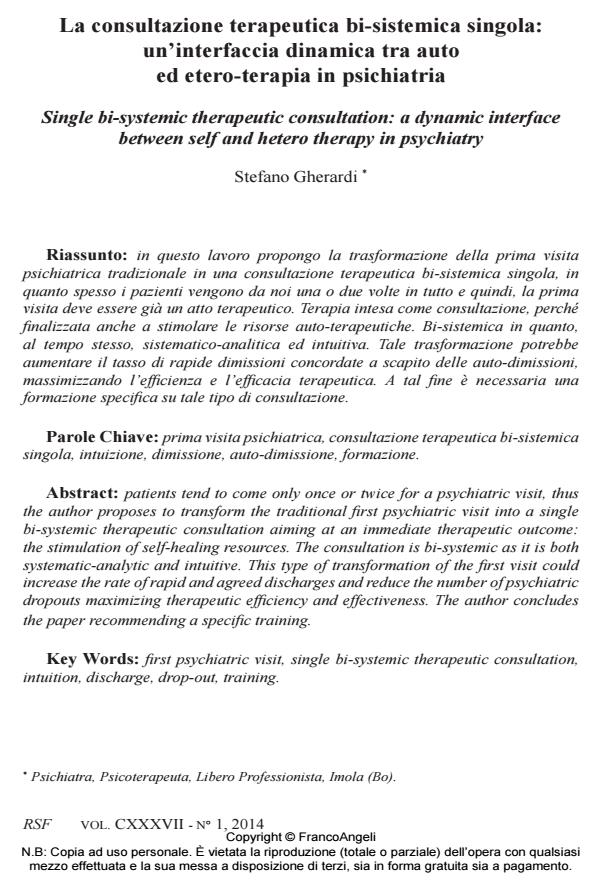Single bi-systemic therapeutic consultation: a dynamic interface between self and hetero therapy in psychiatry
Journal title RIVISTA SPERIMENTALE DI FRENIATRIA
Author/s Stefano Gherardi
Publishing Year 2014 Issue 2014/1 Language Italian
Pages 9 P. 57-65 File size 704 KB
DOI 10.3280/RSF2014-001004
DOI is like a bar code for intellectual property: to have more infomation
click here
Below, you can see the article first page
If you want to buy this article in PDF format, you can do it, following the instructions to buy download credits

FrancoAngeli is member of Publishers International Linking Association, Inc (PILA), a not-for-profit association which run the CrossRef service enabling links to and from online scholarly content.
Patients tend to come only once or twice for a psychiatric visit, thus the author proposes to transform the traditional first psychiatric visit into a single bi-systemic therapeutic consultation aiming at an immediate therapeutic outcome: the stimulation of self-healing resources. The consultation is bi-systemic as it is both systematic-analytic and intuitive. This type of transformation of the first visit could increase the rate of rapid and agreed discharges and reduce the number of psychiatric dropouts maximizing therapeutic efficiency and effectiveness. The author concludes the paper recommending a specific training. .
Keywords: First psychiatric visit, single bi-systemic therapeutic consultation, intuition, discharge, drop-out, training
- [1] Murakami H. L’uccello che girava le viti del mondo. Torino: Einaudi; 2007.
- [2] Gherardi S. Il dipartimento di salute mentale eccellente. Psichiatria di Comunità 2007; VI: 118-26.
- [3] Galgano A. La qualità totale. Milano: Il Sole-24 Ore; 1990.
- [4] Gherardi S. Dalla prima visita psichiatrica alla terapia a sessione singola: un nuovo paradigma? Psichiatria di Comunità 2008; VII: 141-48.
- [5] Rossi A, Amaddeo F, Sandri M, Marsilio A, Bianco M, Tansella M. What happens to patients seen only once by psychiatric services? Findings from a follow-up study. Psychiatry Research 2007; 157: 53-65. DOI: 10.1016/j.psychres.2006.05.02
- [6] Curci P, Secchi C. L’atteggiamento psicoterapico: un fondamento per la diagnosi nella pratica psichiatrica. Nóos 2000; 6: 239-56.
- [7] Bologna M, Fiaschi MD. La seduta singola nella prospettiva della resilienza. Psichiatria di Comunità 2011; X: 132-42.
- [8] Jerry PA. Winnicott’s therapeutic consultation and the adolescent client. Crisis Intervention and Time-limited Treatment 1994; 1: 61-72.
- [9] Talmon M. Psicoterapia a seduta singola. Trento: Erickson; 1996.
- [10] Winnicott DW. Therapeutic consultations in child psychiatry. New York: Basic Books; 1971.
- [11] Gislon MC, Bologna M, Borziani AM, Crosato S, Fiaschi M, Mascara M. Il costrutto della resilienza in psicoterapia focale breve. Rivista Sperimentale di Freniatria 2010; CXXXIV: 75-96.
- [12] Gherardi S. Terapia intuitiva in psichiatria e psicoterapia. L’altro 2009; XII: 29-31.
- [13] Gherardi S. Intuizione come intelligenza dell’inconscio. L’altro 2011; XIV: 14-18.
- [14] Jung CG. Tipi psicologici. Roma: Newton Compton; 1993.
- [15] Winnicott DW. Esplorazioni psicoanalitiche. Milano: Raffaello Cortina; 1995.
- [16] Zapparoli GC. Trasformare le difficoltà in vantaggi: dalle resistenze all’alleanza attraverso l’ascolto dei bisogni. Link, Rivista Scientifica di Psicologia 2009.
- [17] Kahneman D. Pensieri lenti e veloci. Milano: Mondadori; 2012.
- [18] Waelder R. Selection criteria for the training of psychoanalytic students. International Journal of Psychoanalysis 1962; 43: 283-86.
- [19] Baylor AL. A U-shaped model for the development of intuition by expertise. New Ideas in Psychology 2001; 19: 237-44. DOI: 10.1016/S0732-118X(01)00005-8
- [20] Bion WR. Attenzione e interpretazione. Roma: Armando; 2010.
Stefano Gherardi, La consultazione terapeutica bi-sistemica singola: un’interfaccia dinamica tra auto ed etero-terapia in psichiatria in "RIVISTA SPERIMENTALE DI FRENIATRIA" 1/2014, pp 57-65, DOI: 10.3280/RSF2014-001004